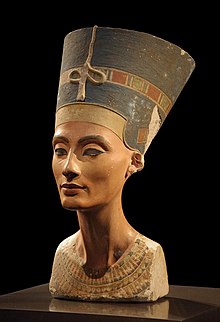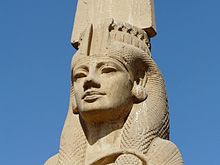


Portraiture in ancient Egypt forms a conceptual attempt to portray "the subject from its own perspective rather than the viewpoint of the artist ... to communicate essential information about the object itself".[1] Ancient Egyptian art was a religious tool used "to maintain perfect order in the universe" and to substitute for the real thing or person through its representation.[2]
Artistic conservatism during the 3000 years of the Dynastic age was a direct result of the ideal of Ma'at. Modification and innovation would have moved art away from the initial state of perfection that was present at the time of the creation of the universe.[2] The deceased "had to advertise for his or her adherence to ... Ma'at" and therefore, chose the most perfect way to represent him/herself and excluded his/her imperfect qualities.[3] In this civilisation, "a statue of a person was believed to be a permanent abode for the spirit of that individual and guaranteed his or her eternal life after death".[4] Such idealized representation of the deceased made him "eternally beautiful" and attested to his sinless life.[3] In an attempt to "convey the spectrum (and totality) of the deceased's personality" rather than merely the physical image, there was a "reluctance to show individual features ... because it conflicted with the representation of the perfect person".[5]
When discussing portraiture in ancient Egypt it is important to differentiate between the modern concept of portraiture and its ancient Egyptian counterpart. In Western art, portraiture captures the exact physical resemblance of a person as well as his/her inner qualities. Ancient Egyptian art had religious roots and functions, and therefore, the result is quite different. To assess ancient Egyptian art and portraiture, it must be examined on its own terms and within its specific cultural context.